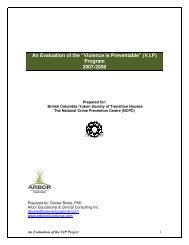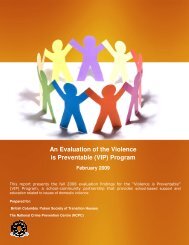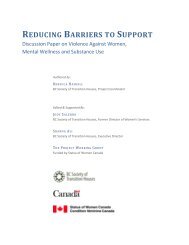a guide to supporting children exposed to domestic violence
a guide to supporting children exposed to domestic violence
a guide to supporting children exposed to domestic violence
You also want an ePaper? Increase the reach of your titles
YUMPU automatically turns print PDFs into web optimized ePapers that Google loves.
4<br />
Protecting yourself and your <strong>children</strong><br />
THIS CHAPTER LOOKS AT<br />
your safety: always the first priority<br />
obstacles you may face if you decide <strong>to</strong> leave<br />
getting help with particular challenges<br />
managing stress and taking care of yourself<br />
taking legal action<br />
what <strong>to</strong> expect if you leave an abusive relationship<br />
Your safety: always the first priority<br />
This refers particularly <strong>to</strong> relationships where your partner is physically or sexually<br />
abusive or threatens you with harm.<br />
• Even if you have left your partner, you may still have <strong>to</strong> deal with abusive<br />
behaviour.<br />
• You need <strong>to</strong> remember that you can’t control your partner’s behaviour. But there<br />
are steps that you can take that will increase your safety.<br />
• Any woman who is abused by her partner is constantly assessing the risks she<br />
faces. She develops ways <strong>to</strong> try <strong>to</strong> protect herself and her <strong>children</strong>, which she<br />
uses and adapts on a daily basis.<br />
• You have probably already done a number of things <strong>to</strong> try <strong>to</strong> keep you and the<br />
<strong>children</strong> safe. The things you do <strong>to</strong> keep safe are your safety plan, even though<br />
you may not have used the term, “safety plan.”<br />
• Each woman’s safety plan is unique <strong>to</strong> her and her situation. Many women find<br />
it helpful <strong>to</strong> actually make a safety plan because it is difficult in a crisis <strong>to</strong> think<br />
clearly and make safe decisions.<br />
• There is an outline for a safety plan in the Resources section. You could use<br />
this outline <strong>to</strong> develop your own safety plan.<br />
• Try <strong>to</strong> get help with developing your safety plan. The section in chapter 7,<br />
“Finding information and support in your community” has suggestions of who<br />
might help.<br />
HELPING MY CHILD A GUIDE TO SUPPORTING CHILDREN EXPOSED TO DOMESTIC VIOLENCE 23






